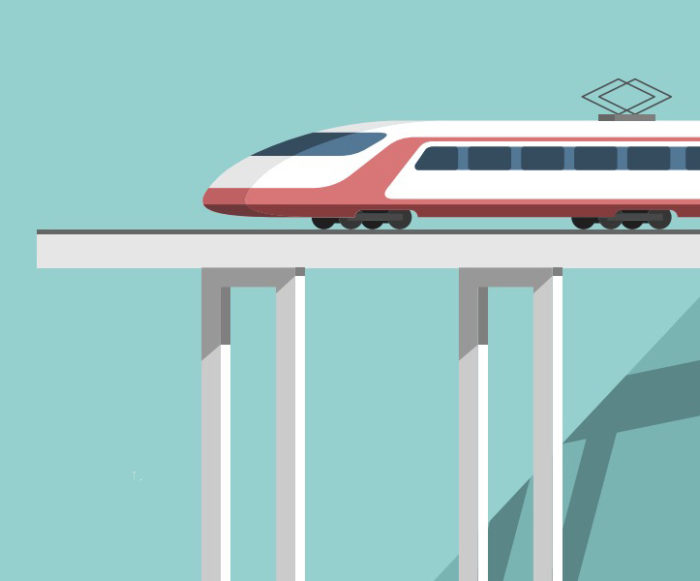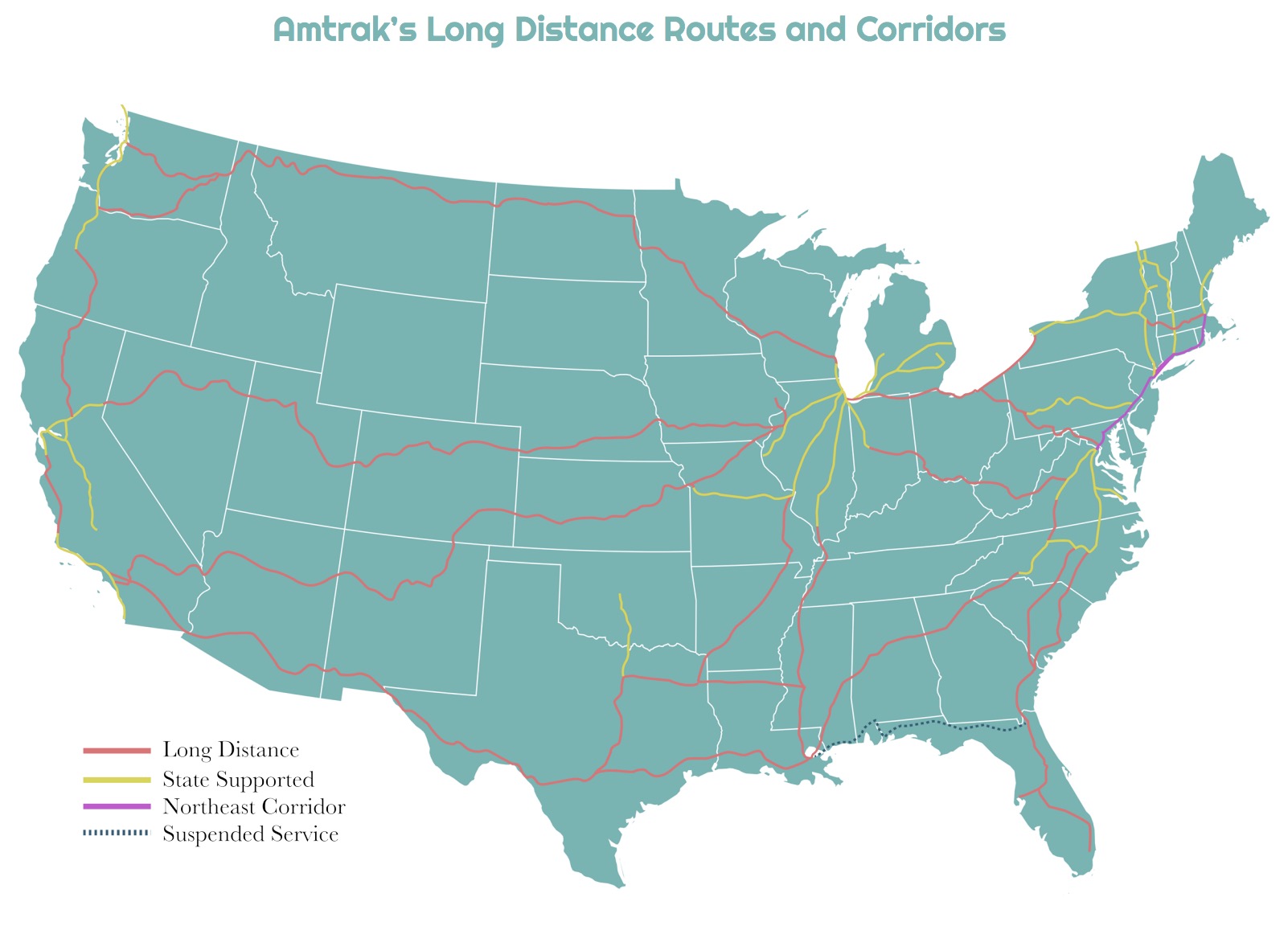NATIONAL ASSOCIATION OF RAILROAD PASSENGERS (NARP)
Dismantling a National Transportation Network: The faulty assumptions behind proposals to preserve passenger rail service only for the Nation’s wealthiest travelers.
Part 1 – Introduction
 The Trump Administration’s FY2018 budget proposal calls for eliminating Amtrak’s long distance passenger rail service while preserving service for the Northeast Corridor (NEC) and state supported routes. The justification for the proposal is that Amtrak’s long distance routes aren’t “profitable.”
The Trump Administration’s FY2018 budget proposal calls for eliminating Amtrak’s long distance passenger rail service while preserving service for the Northeast Corridor (NEC) and state supported routes. The justification for the proposal is that Amtrak’s long distance routes aren’t “profitable.”
Similar proposals have been offered in the past by a few public policy organizations such as the Heritage Foundation and the Cato Institute. These organizations have periodically persuaded their allies in Congress to call for a vote on eliminating Amtrak subsidies. Those efforts failed by substantial margins.
In 2015, for example, the U.S. House of Representatives considered an amendment by Rep. Tom McClintock (R-California) that would eliminate all federal funding for Amtrak. The amendment failed by a vote of 147 ayes to 272 noes (35% aye – 65% no). Also in 2015, Rep. Mo Brooks (R-Alabama) offered an amendment to eliminate all operating subsidies for Amtrak. It failed by a vote of 143 ayes to 283 noes (34% aye – 66% no).
Despite Congress’ rejection of deep cuts, the Trump Administration has resurrected the idea of dismantling Amtrak’s national network of passenger rail service routes.
This discussion of eliminating “unprofitable” Amtrak routes is occurring while the nation’s transportation infrastructure is deteriorating and the nation is struggling to reach a consensus on how to address a decades-long pattern of underinvestment in our infrastructure.
The grim state of our national transportation infrastructure requires well-informed leadership, both in the Administration and the Congress.
Consequently, the purpose of this report is to explore the rationale behind the Trump Administration proposal and provide a factual basis for any discussion of passenger rail service, particularly as Congress develops legislative remedy for our ailing transportation infrastructure.
Part 2 – Amtrak’s National Network: A Brief Overview
To fully grasp the impact of the Trump Administration’s proposal, it is important to understand the two basic components of Amtrak’s national network.
Long Distance Routes: As one might deduce from the name, long distance routes traverse large swaths of land, connecting the major regions of the country. Each of the 15 long distance routes, shown in orange on the map below, are anchored at either end by major cities but make numerous stops at stations in smaller cities and towns along the way. These routes would be eliminated under the Trump Administration’s proposal.
Corridors: Corridors are shorter, high traffic paths between two points within a state or region of the country.
- The Northeast Corridor, shown in purple on the map above, covers a densely populated, high traffic line stretching from Washington, DC to Boston, MA. It includes both the faster and more costly Acela Express service and the slower and less expensive Northeast Regional service.
- State-supported corridors, shown in yellow on the map above, are financially supported by state taxpayer dollars through cooperative agreements between Amtrak and the relevant state transportation agencies. Per the “Passenger Rail Investment and Improvement Act of 2008,” state partners provide 85% of the funding and Amtrak provides 15%.5 There are 29 state supported corridors in 18 states. An example of a state-supported corridor is the Heartland Flyer, which provides daily service between Oklahoma City, OK, and Fort Worth, TX, with stops at five smaller cities and towns along the line.
Although routes and corridors are sometimes discussed as if they were separate, distinct pieces, they are actually intertwined through passenger choice. It is important to bear in mind that passengers often transfer from a corridor to a long distance route or vice versa.
To better understand this relationship, it might be helpful for some readers to compare Amtrak’s national network to Washington DC’s subway system. A passenger might begin a daily commute on the Red Line from a station in an Upper Northwest residential neighborhood, transfer to the Blue Line at Metro Center, and disembark at the Capital South station. Both the Red Line and the Blue Line are critical components of that daily trip. Without one component, the passenger is likely to choose a different mode of transportation.
Part 3 – The Assumption of Survivability
The Trump Administration’s proposal assumes that it will be a simple matter to break up Amtrak’s national network into pieces, discard the “unprofitable” pieces, and allow service to continue on the “profitable” remnants. It would be prudent to challenge the assumption that the remnants of the network – the Northeast Corridor and the state supported corridors – would be able to survive in the aftermath.
As with any network, Amtrak’s corridors and long distance routes have a symbiotic relationship; both feed passengers, and thus revenue, to the other. Without one, they both suffer.
For example, consider a passenger who is traveling from Battle Creek, MI to Denver, CO. The passenger begins the journey on a Michigan-supported state corridor train from Battle Creek to Chicago and then transfers to a federally supported long distance train for the Chicago to Denver leg of the trip. If the federally supported long distance train running from Chicago to Denver is eliminated, then the passenger has no reason to use the state supported train. Consequently, this state-supported corridor would experience a revenue loss.
As connecting ridership, and thus revenue, drops on the state supported corridor trains, the amount of money the states would have to pay for their corridor service would rise. State budgets have been under enormous pressure for the past decade, making it unlikely that most states could sustain a new drain on revenues for an extended period of time. At some point, the states may say “enough is enough” and make the difficult decision to halt funding for their corridors, which would then lead to their elimination.
In addition to lost passenger revenues on state-supported routes, Amtrak’s relatively fixed overhead costs would have to be divided up among the fewer and fewer remaining corridors, which would drive up the cost of providing service on the remnants of the network.
The talking points for eliminating Amtrak’s long distance routes might present a rosy picture of a clean, simple breakup but eliminating long distance routes would certainly trigger a downward spiral for the remaining corridors.
Download full version (PDF): Dismantling a National Transportation Network
About the National Association of Railroad Passengers (NARP)
www.narprail.org
NARP is the largest national membership advocacy organization for train and rail transit passengers. We have worked since 1967 to expand the quality and quantity of passenger rail in the United States. Our work is supported by around 28,000 individual members.
Tags: Amtrak, Amtrak's National Network, Long-Distance Trains, NARP, National Association of Railroad Passengers, Rail Travel, trains







 RSS Feed
RSS Feed